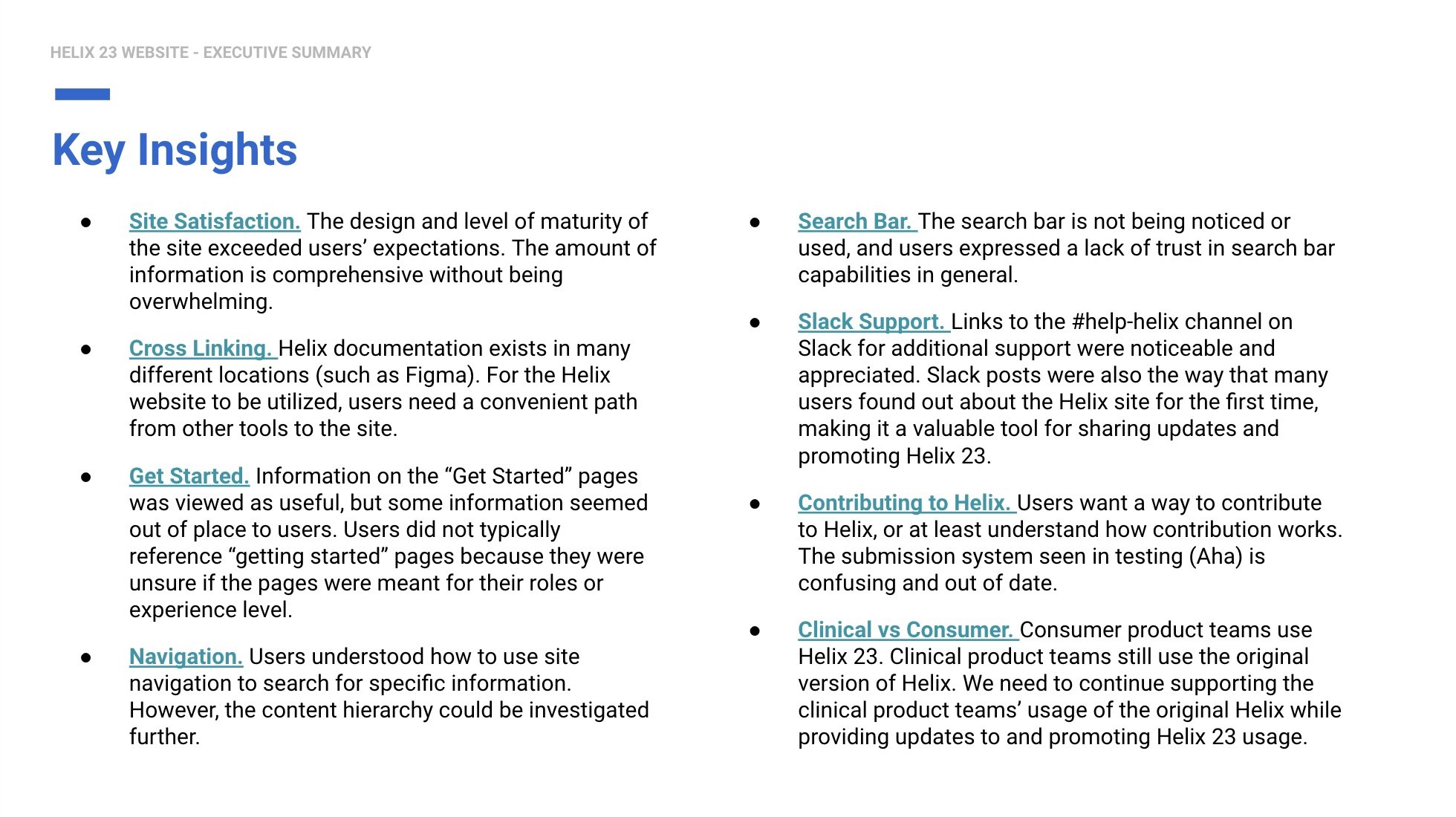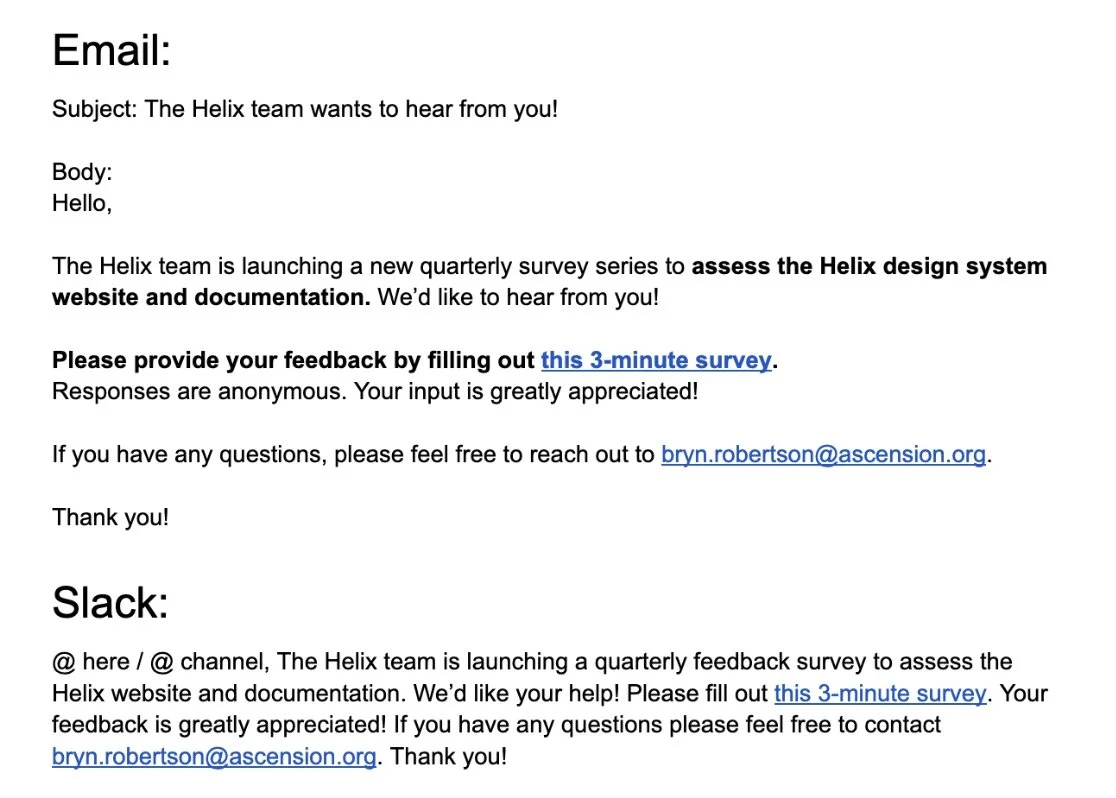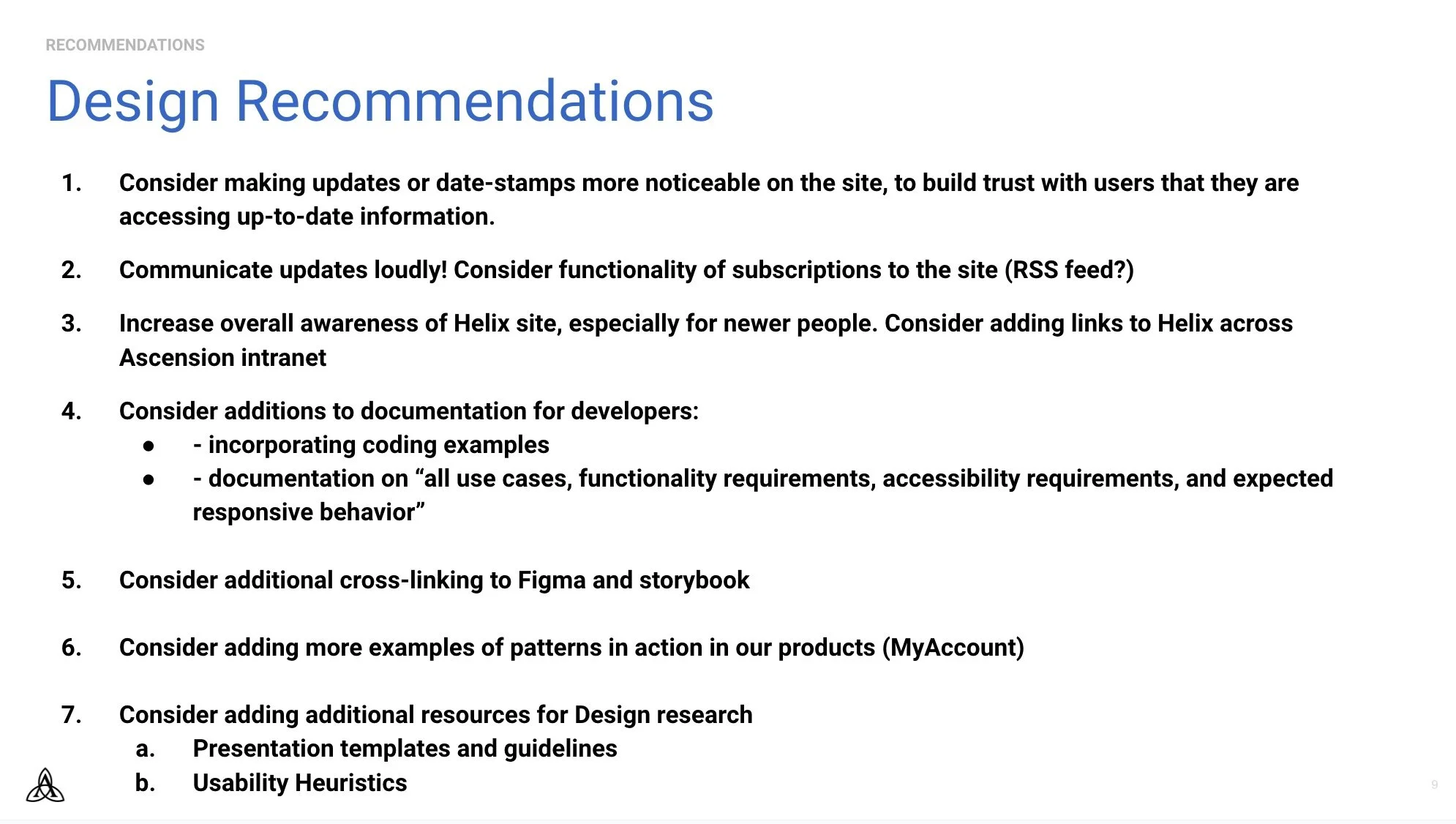Ascension Design System Website Study
Usability Study, Longitudinal Survey Program
Conducted a remote moderated contextual inquiry / usability study and launched a longitudinal survey study to evaluate Ascension’s design system website.
Duration: 16 weeks
Employer: Ascension
My Role: Design Researcher
Usability Study: I developed the usability testing protocol, screened and recruited users, moderated usability testing sessions, synthesized qualitative data, and presented design recommendations to stakeholders at Ascension.
Survey Study: I also launched a longitudinal survey program to gather quarterly user insights about the website. I designed and administered the first round survey, recruited participants, synthesized qualitative and quantitative findings, and presented my findings to stakeholders.
CONTEXT
During my time as a design researcher at Ascension, a private healthcare nonprofit, I was tasked with evaluating the internal documentation for Ascension’s design system, Helix.
During this research, Ascension was actively transitioning to a new version of its design system, and a new section of the website was made available to document the latest version, Helix 23. The user base of the original version was shrinking rapidly, and the new version was being used by different types of users, including designers, developers, and product teams. This research was conducted to ensure each of these user groups were able to find and effectively use the site.
I first evaluated the discoverability and usability of the primary source of documentation, the Helix website.
Following that study, I launched a quarterly survey to assess the website over time.
The Helix 23 homepage offers an overview of the latest components.
CONTEXTUAL INQUIRY / USABILITY STUDY
OBJECTIVES
For the first round of research, I worked with the design team to elicit the following groups of research questions.
DISCOVERABILITY:
Where are users deriving their design system information? Does this differ between user types?
Do users know about the Helix website at all? Can users find the Helix website?
How and When do users navigate to the Helix website in their workflow?
USABILITY:
Does the information architecture and content hierarchy of the website make sense to users?
Are users able to navigate to a specific point of information on the site?
If so, are they satisfied with the amount of time it took them to find that information?
Are users comfortable with the amount of information presented on the website?
Are users aware of the search function? Do they use it? Why or why not?
By talking through the differences between discoverability and usability in my initial conversations with stakeholders, I was able to understand the objectives for my research and structure my user sessions.
METHODOLOGY
Sessions were conducted remotely via Google Meet.
To investigate the discoverability of the Helix website, I chose to begin the user sessions as a contextual inquiry.
Users were asked to start with a blank screen and to walk through a current project.
Then, users were asked how they typically used design systems in their work, and asked to show an example of how they would access documentation for the design system.
In some sessions, the participants navigated organically to the Helix website. In other cases, users showed me different sources of design system documentation. These pathways and alternative resources were documented, and users were directed to the Helix website.
The moderator script included directions for the moderator to transition from unstructured contextual inquiry to a usability study of the Helix website.
Once users landed on the Helix website, I transitioned the session to a usability study.
I asked the users to explore the website and provide their initial thoughts, then I gave the users a set of tasks to complete to evaluate the usability of the website.
I started with an easier task, and asked users to find the “icons” page. I then graduated to a harder task and asked users to find a specific piece of information on the radio buttons component page. Finally, I asked the users “cool down” questions about their overall perceptions of the website.
I chose to start and end the usability session with easier tasks and questions to build rapport and allow the users to familiarize themselves with the website.
The moderator script included the task for the user, success/failure criteria, potential follow-up questions, and the amount of time to spend on each task.
RECRUITMENT
Participants were recruited internally through convenience sampling.
Users were recruited through word-of-mouth and Slack posts on internal channels.
To decrease bias, I avoided “power users” or users who would be highly familiar with Helix and any recent changes to the website.
I created a screener to recruit participants with a variety of experience with Helix.
DOCUMENTATION
Study plan
After an initial meeting with stakeholders, I created a study plan to summarize research questions, intended methodology, recruiting and participant criteria, deliverables, and a study schedule.
The study plan was a living document shared with all stakeholders and updated throughout the study.
Script + Note-Taking Spreadsheet
I wrote a script for the sessions and translated it into a note-taking spreadsheet that could be used by other team members who were assisting with note-taking during the sessions.
The spreadsheet included both note-taker observations and success/failure measures for certain tasks.
SYNTHESIS
Co-Synthesis Session
I translated my teammates’ notes from the sessions into sticky notes in FigJam.
I then organized and facilitated two co-working sessions for the team to first discuss our initial findings during the sessions and then group the findings into clusters.
Inviting the team to participate in the synthesis process allowed me to be transparent about my research process, provide a space for discussion, and share a birds-eye view of the research findings.
First, I had the team sort notes into two categories: what worked well, and what didn’t work well.
Then, we worked to cluster the sticky notes into thematic groups.
Finally, for each thematic group the team discussed insights and potential impacts or decisions to be made based on our observations.
PRESENTATION
Reporting Deck
I further synthesized the notes from the co-synthesis sessions and prepared a slide deck with the methodology and research insights. I presented this deck to the design team and stakeholders.
The deck was designed to stand alone so that future researchers would know the purpose, methodology, and findings of this research, and would be able to continue this line of research in my absence.
The key insights slide provides an overview of the study findings.
Both design and strategy recommendations are included where relevant, as well as opportunities for future research.
Individual insight slides include an insight statement, details about the finding, photo examples, quotes, and recommendations.
IMPACT
After the reporting of insights, design changes were made to the Helix website, that reflected insights revealed in the study. This research also influenced the communication strategy around promoting the Helix website to new and existing users.
Minor changes to the website were made, including updating wording and spacers for clarity.
Duplicate sources of design system documentation were reduced across platforms.
The strategy was solidified for communicating website updates and accessing help via an internal slack channel.
To further measure the impact of updates to the Helix website, I launched a longitudinal survey program.
LONGITUDINAL SURVEY PROGRAM
OBJECTIVES
Following the usability study, I launched a quarterly survey program to assess the Helix website.
The purpose of this survey was to investigate how, when, and why different user groups utilized the Helix website, and to gauge perceptions of the website’s usefulness.
User groups were defined by discipline within Ascension and included Product, xRD, Engineering, and Other.
Additionally, a net promoter score question was used to assess sentiment towards the website across user types.
SURVEY METHODOLOGY + RECRUITMENT
I designed a short survey using Google Forms.
All users were first given the same general survey, and then directed to a specific set of questions depending on their user group.
This allowed me to assess the website across user types, as well as dig deeper into specific contexts only relevant to some users.
The survey included multiple choice questions, likert scale questions, and short answer follow ups.
To recruit participants, I leveraged my connections and the connections of the team to leadership at Ascension.
I prepared a few different versions of recruitment text that could be shared via slack post, email, or in a meeting.
I then contacted design, engineering, and product leadership to assist in promoting the survey. I provided a brief overview of the research, the deadline for survey responses, and thanked them for assisting in the research process.
DATA ANALYSIS + PRESENTATION
For qualitative data, I included user quotes and summarized key insights with a red, yellow, or green tag indicating severity.
I synthesized qualitative and quantitative data into 7 design recommendations across user groups.
For quantitative data, I included basic descriptive statistics and highlighted differences between user groups.
Once all responses were collected, I used Google Sheets to analyze the data. I calculated NPS data and descriptive statistics for relevant portions of the survey.
I then prepared a slide deck with insights from the first round survey, and presented my findings to stakeholders.
NEXT STEPS
The survey will be promoted quarterly and future results will be compared against past rounds of research.
Given that I may not be the researcher to facilitate the next survey round, I ensured that the methodology was well-documented and that the Helix team had access to all study materials prepared for this survey program.
REFLECTION
This project allowed me to showcase my skills from the beginning to the end of the research process. From initial meetings with the design team through strategic discussions after my presentations, I had the support of a great team and felt empowered in my decision making as a researcher. Special thanks to Tony for all of the mentorship and guidance throughout this project- I couldn’t have done it without you!








